Grassroots Champions: Barangay Health Workers Lead the Way to Reduce Adolescent Pregnancy in Lapu-Lapu
Lapu-Lapu City in Central Visayas faced a rising adolescent birth rate (ABR), increasing from 14 births per 1,000 adolescents in 2020 to 23 in 2023. At the same time, modern contraceptive prevalence rate (mCPR) dropped from 31% to 21%. Local health officials saw that, while women continued to seek services, many still relied on short-acting family planning methods. Uptake of long-acting options was growing but needed stronger community support.
To respond to the alarming numbers, the city partnered with The Challenge Initiative (TCI), a global program implemented in the Philippines by the Zuellig Family Foundation that helps local governments scale proven family planning and adolescent and youth sexual and reproductive health (AYSRH) solutions.
Related articles:
- Nine Cities Recognized as Global Self-Reliant Cities in Reproductive Health
- Lapu-Lapu City’s Path to Strengthening Family Planning and Adolescent Health
The city formed the Lapu-Lapu City Leadership Team to unite health, education, youth, and social welfare sectors. Barangay nurses and midwives then began integrating meaningful conversations into routine services. They learned that many adolescents lacked parental guidance and reliable reproductive health information, while many adult women feared modern methods because of misconceptions. These issues showed that rising adolescent pregnancies and declining contraceptive use stemmed from the same need: trusted, judgment-free health information within the community.
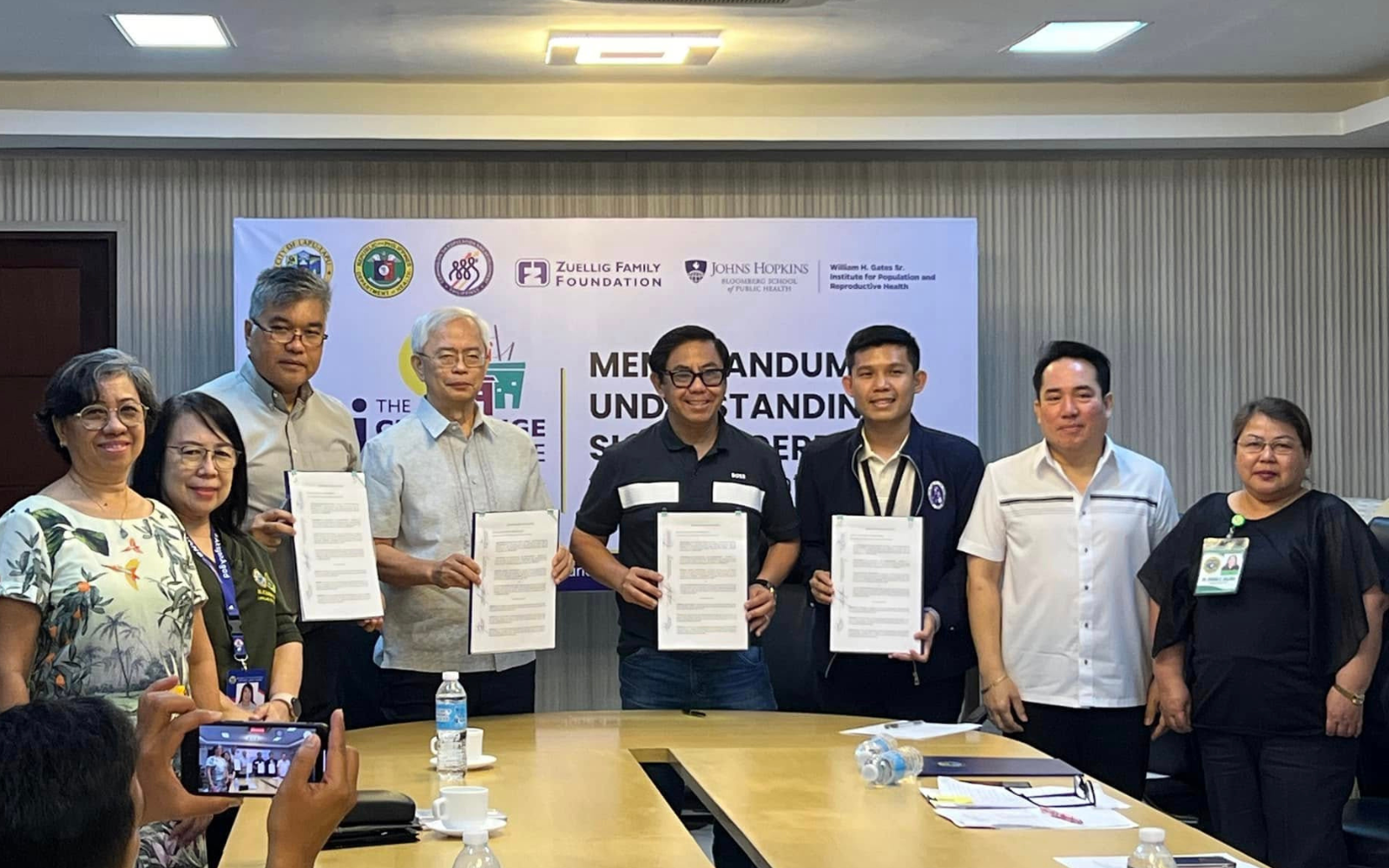
Lapu-Lapu City placed communities at the center of its strategy. Awareness efforts shifted the conversation from contraceptives alone to responsible parenthood.
Barangay Health Workers (BHWs)—trusted members of each neighborhood—played a central role. Through house-to-house visits, they profiled households, explained family planning options, and corrected myths using simple materials. BHW Coordinator Jovy Alonzo emphasized that all BHWs are trained in adolescent health and development and uphold confidentiality and nonjudgmental support. Their strong performance earned Lapu-Lapu’s BHWs the Performance-Based Incentive (PBI) Award for two consecutive years, making them PBI Champions in Central Visayas. As Nurse Grace Mary Chan-Carunggay shared, “This recognition is a testament to their exceptional service and dedication.”
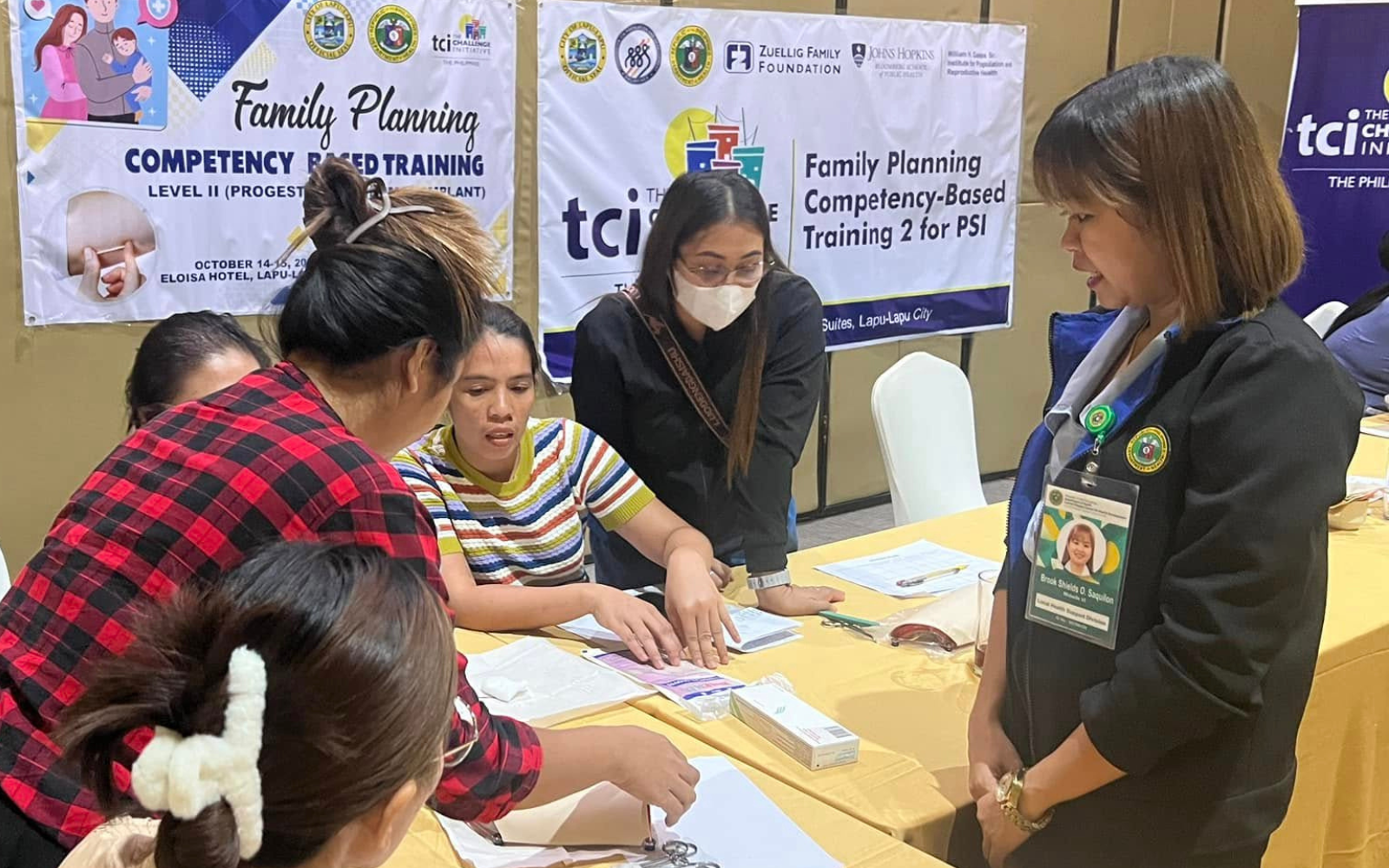
The city also strengthened its service delivery system by training more providers through Family Planning Competency-Based Training (FPCBT), especially in barangays with limited access. This allowed more health centers to offer long-acting reversible contraceptives (LARC), including the Progestin Subdermal Implant. City leaders supported these improvements by funding BHW incentives and training, conducting regular barangay visits, and ensuring data quality for planning. According to City Health Officer Dr. Agnes Cecilia Realiza, “Adolescent parents are now coming to our health centers. They no longer feel stigmatized, and they seek prenatal care, ensuring the safety of both mother and child during delivery.”
In 2024, the city recorded only one additional adolescent pregnancy case, showing early signs of progress. The drop in mCPR was largely due to data cleaning, which corrected the number of women counted in the program. Lapu-Lapu is also adjusting to the shift in national indicators—from mCPR to “demand satisfied”, or the share of women with a need for family planning who use modern methods. The City Health Office continues to improve staff capacity for accurate data use and coaching.

Lapu-Lapu’s experience shows the power of community-centered, data-driven leadership. By investing in AYSRH and allocating dedicated budgets, the city has strengthened the work of BHWs and sustained community engagement. With a 22% increase in AYSRH budget commitments, based on TCI-Philippines monitoring, Lapu-Lapu demonstrates that empowering frontline workers creates lasting impact—helping young people make informed choices for their health and future.
Slowly but Surely: Iriga City’s Inclusive Path to Family Planning among Indigenous Peoples
Iriga City is home to diverse communities, including many indigenous peoples (IPs). Like other areas, the city faces reproductive health challenges such as misconceptions about family planning (FP), cultural hesitations, and difficulty reaching families in geographically isolated and disadvantaged areas (GIDAs).
In July 2023, the city joined The Challenge Initiative (TCI), a global platform implemented in the Philippines through the Zuellig Family Foundation. With this partnership, the Iriga City Government and the City Health Office renewed their efforts to strengthen FP and adolescent and youth sexual and reproductive health (AYSRH), ensuring even the most underserved communities were included.
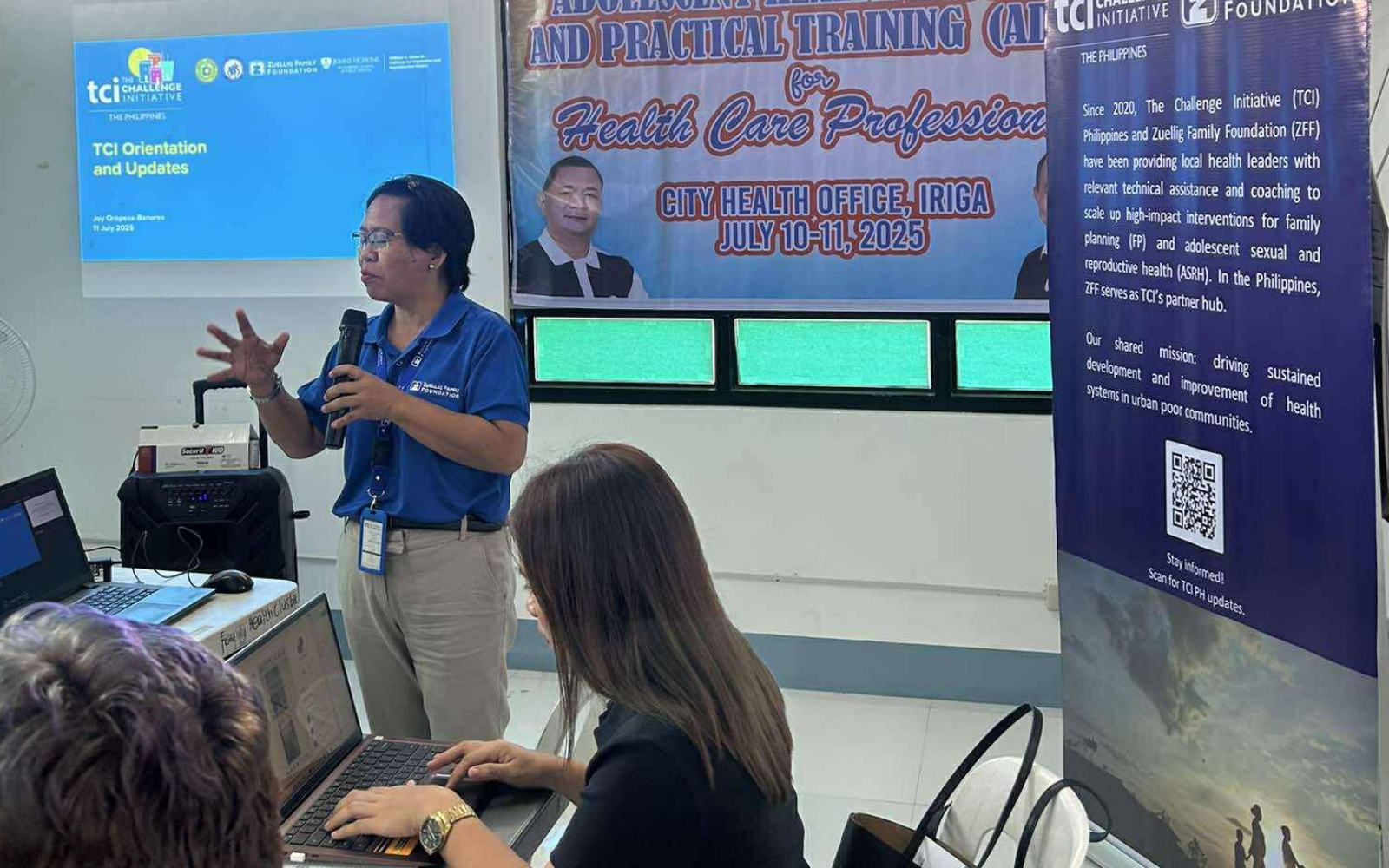
Related article:
Stories from the Frontlines
FP Coordinator Cyrene Oliva shared how TCI’s approaches helped Iriga improve data quality and slowly raise its modern contraceptive prevalence rate (mCPR). “Even if our mCPR dipped at first, we saw this as progress—because this time, our data was accurate. Now, with strengthened verification and continuous community engagement, our mCPR is climbing steadily again,” she said.
City Health Officer Dr. Ronald Pereña noted that mothers often hesitated to pursue family planning methods due to side effects, irregular supplies, and cultural expectations to seek their husband’s approval. Adolescents were also shy at first, but Oliva said that repeated discussions helped them open up. Several barangays later earned Certificates of Compliance as Level 1 Adolescent-Friendly Health Facilities—an important step under the AYSRH program.
Population Program Officer Mayet Amoroso Nacario observed that continuous awareness campaigns helped shift attitudes. “Before, many youth and even officials had little knowledge of adolescent health. Now, they are aware and more open. Teenage pregnancy still rises and falls, but families and schools are no longer ignoring it. There is now action and support,” she said.
Bridging Culture and Care
The city expanded FP access through Purok Kalusugan, a barangay-based initiative that integrates Department of Health (DOH) services at the purok level. Teams provided counseling, commodities, and even long-acting methods through house-to-house visits.
TCI supported Family Planning Competency-Based Training (FPCBT), enabling barangay workers to offer methods like implants and IUDs. This investment helped Iriga reach more IP communities in remote areas. Acceptance grew when IP barangay health workers—who were FP users themselves—became local champions.
Nacario shared that trust improved through repeated visits, conversations with leaders, and visible examples such as a chieftain choosing an implant. Dr. Pereña added, “Slowly but surely, you have to make them realize the big picture, that family planning will protect their health and wellbeing.”
Regular quality implementation checks, including monthly reviews and coaching, strengthened service delivery and ensured that adolescent-friendly facilities and FP programs remained responsive.
Stepping Up, Growing Up
Iriga also encouraged male involvement. More men began to ask for condoms and join FP discussions. Oliva recalled one husband who offered to have a vasectomy as a Valentine’s gift to his wife, saying it was his turn to share the responsibility.
The city also expanded AYSRH work in schools through the Department of Education (DepEd). Activities such as U4U Teen Trail sessions and age-appropriate film showings helped students learn about reproductive health and their rights. “Schools now invite us on their own,” Nacario said. “They even ask, ‘When will you come to our students?’ That’s proof that adolescent health is no longer taboo in Iriga—it is a collective priority.”
Sustaining Progress Together

Iriga built its FP and AYSRH efforts on trust, cultural sensitivity, and sustainability. The city allocated local funds, including support for IP communities, to ensure programs continue even after external support ends. Partnerships with DOH, the Commission on Population and Development (CPD), ZFF, and TCI provided coaching and capacity-building, while local leaders and women’s organizations strengthened community ownership.
As Dr. Pereña shared, family planning is now part of Iriga’s long-term development plans. The city’s journey shows that even the most hard-to-reach families can make informed choices when programs are inclusive, respectful, and community-driven.
Leading from the Future: Reflections from the International Conference on Family Planning
When our team boarded the flight to Bogotá for the 2025 The Challenge Initiative (TCI) Annual Meeting and the International Conference on Family Planning (ICFP), we carried more than presentations and data sets. We carried the stories of 24 Philippine cities that have chosen to lead boldly in family planning (FP) and adolescent sexual and reproductive health (ASRH). As a relatively young hub in the global TCI network, the Philippines has always been both a learner and a contributor. This year, however, felt different. For the first time, we arrived not merely to listen but to help shape the direction of the Initiative.
Related articles:
- Nine Cities Recognized as Global Self-Reliant Cities in Reproductive Health
- Eight Cities Share Success in Family Planning and Adolescent Health
A Gathering Shaped by Urgency and Imagination
The theme of the Annual Meeting, “Lead from the Future,” captured the spirit of the meeting. Representatives from six TCI hubs across 13 countries came together, each navigating shrinking donor resources, political transitions, and data challenges. Yet despite these pressures, the mood was determined and forward-looking.
In his opening message, TCI Executive Director Kojo Lokko reminded us that the Initiative’s evolution—from Good to Great and Growth Mindset to Reaching New Heights—has always pointed toward long-term sustainability. Leading from the future, he explained, requires clarity about what we hope to achieve and the discipline to act today in ways that bring that vision closer to reality.
Listening to him, I saw how closely this reflects the Philippine journey. In five years, we moved from launching a hub at the height of a lockdown to establishing governance, leadership development, data use, and sustainable financing as the backbone of city programs. Our experience has been a constant cycle of learning, adapting, and improving—often under constraints but always grounded in the belief that cities can lead the change themselves.
Local Leadership at the Center
Our delegation brought this story to the global stage through five scientific presentations at ICFP and through the voices of two city partners: Dr. Benson Panaguiton, City Health Officer of Dipolog City, and Judith Catalan Janiola, City Population Officer of General Santos (GenSan) City.
Judith’s presentation on GenSan’s experience captured attention. She described how local leaders use data not only to monitor performance but also to solve problems, realign priorities, and motivate teams. She highlighted practical actions driven by partnerships with youth organizations, faith leaders, barangay officials, and civil society groups. These efforts helped reduce teenage pregnancies and strengthened community ownership.
A Shifting Global Landscape
Across sessions—from Bayer’s keynote to discussions on domestic financing—a consistent message emerged: the global environment for FP is changing rapidly. Donor funding is tighter, pronatalist and anti-rights movements are gaining momentum, and climate disruptions are affecting service delivery. Health systems must now be more resilient, adaptable, and grounded in local ownership.
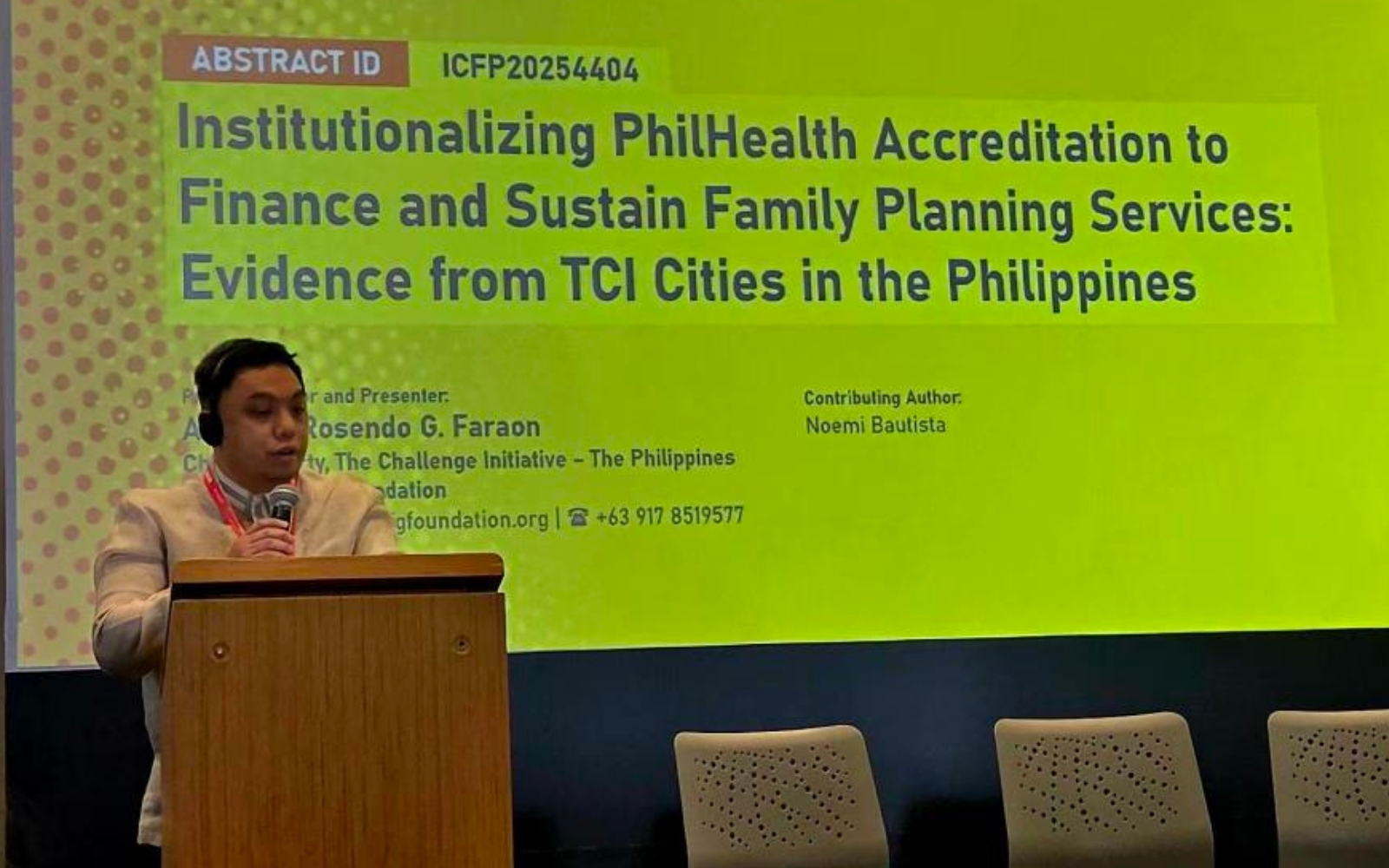
During a flash-oral presentation, I shared how Philippine cities are beginning to tap PhilHealth reimbursements to finance FP services. This drew interest, especially from teams exploring sustainable financing models. The idea that a national insurance system can support FP programs illustrates the potential of strengthening and fully utilizing local systems.
Our Monitoring, Evaluation, and Learning Manager, John David, also shared how standardized data presentations transformed city leadership meetings. Data became easier to understand and discuss, encouraging more leaders—from mayors to youth representatives—to use evidence as the basis for decisions.
Expanding the Philippine Contribution Through Posters
The delegation also presented three posters highlighting how TCI-Philippines strengthens city systems:
- Deputy Chief of Party Pamela Mangilin showcased the Leadership for Adolescent and Youth-Friendly Cities (LAYFC) youth engagement model, demonstrating how trained young leaders create safe spaces and support adolescent reproductive health.
- City Team Leader Teresa Ferrolino presented how inclusive leadership, multisector collaboration, and community involvement enable cities to integrate FP and ASRH into development plans.
- John David examined inconsistencies between local and national FP data and recommended improvements in data governance.
Collectively, these posters highlighted how the Philippine hub advances youth leadership, governance, and data quality to support sustainable FP programs.
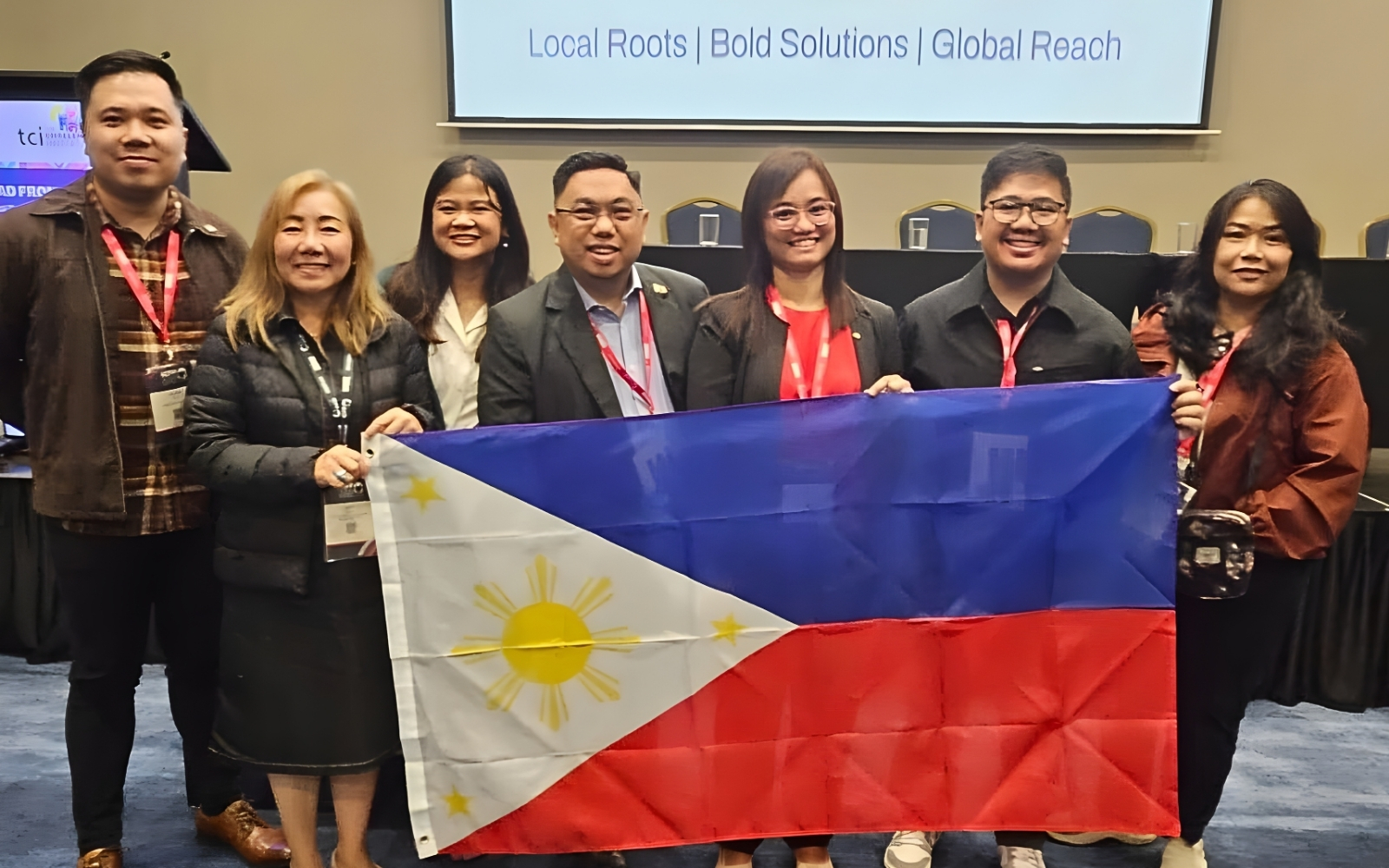
Leading From the Future in the Philippine Context
Some of the most meaningful exchanges happened outside formal sessions. Colleagues from other countries asked how a small Philippine team expanded to 24 cities while maintaining cost-efficiency. They inquired about City Leadership Teams, budget protection, and governance reforms aligned with national systems.
These conversations confirmed that the Philippines is becoming a source of global learning. Our strength lies in combining leadership development, system integration, and practical governance tools—elements that help cities continue performing even in uncertain environments.
To lead from the future in the Philippine context means focusing on what works: building strong leaders, institutionalizing coaching and onboarding, optimizing PhilHealth financing, integrating routine data use, partnering with youth and communities, and preparing FP systems to withstand political and environmental change. It means trusting local governments to lead while providing the right support and accountability mechanisms.
A Future Already Emerging
As our delegation left Bogotá, I felt a renewed sense of direction. The future that TCI envisions is already visible in Dipolog, General Santos, Iligan, and across the other 21 partner cities. These local governments are proving that FP does not survive because of projects; it thrives because leaders take responsibility for it.
Author: Dr. Anthony Faraon, ZFF TCI-Philippines Chief of Party
Nine Cities Recognized as Global Self-Reliant Cities in Reproductive Health
The Zuellig Family Foundation (ZFF) celebrated the graduation of nine cities under The Challenge Initiative (TCI)-Philippines: General Santos, Iriga, Isabela de Basilan, Lapu-Lapu, Pasig, Mandaluyong, Quezon City, Tacurong, and Tagum.
The Batch 3 Colloquium, themed “Sustaining Momentum: Transformative Reproductive Health Impact through Data-Driven Leadership,” took place on October 14, 2025, at the Park Inn by Radisson in Quezon City. The event gathered local government leaders, health officers, and partners from across the country to celebrate how cities strengthened their family planning (FP) and adolescent and youth sexual and reproductive health (AYSRH) programs through evidence-based leadership.
ZFF President and Executive Director Austere Panadero congratulated the cities for their progress. Across the nine cities, data show significant gains: all surpassed the national target for adolescent birth rates or incidence of teenage pregnancy (below 37 births per 1,000 women) and most exceeded the 30% modern contraceptive prevalence rate (mCPR) benchmark. “These are not just numbers,” said Panadero, “Ito ay mga kwento ng pagbabago—of stronger systems, more capable leaders, and communities that now make informed and empowered choices.”
Dr. Anthony Faraon, Chief of Party of TCI-Philippines at ZFF, presented key reproductive health trends, warning that while births among 15–19-year-olds are declining, births among girls below 15 are increasing. He challenged the audience: “Will we act now with the urgency this crisis demands or will we wait until the effects are irreversible?”
Related articles:
- Batch 1: Five Cities Celebrate Milestone in Adolescent Health and Family Planning Efforts
- Batch 2: Eight Cities Share Success in Family Planning and Adolescent Health
Panel 1: Family Planning Demand Generation and Service Innovations
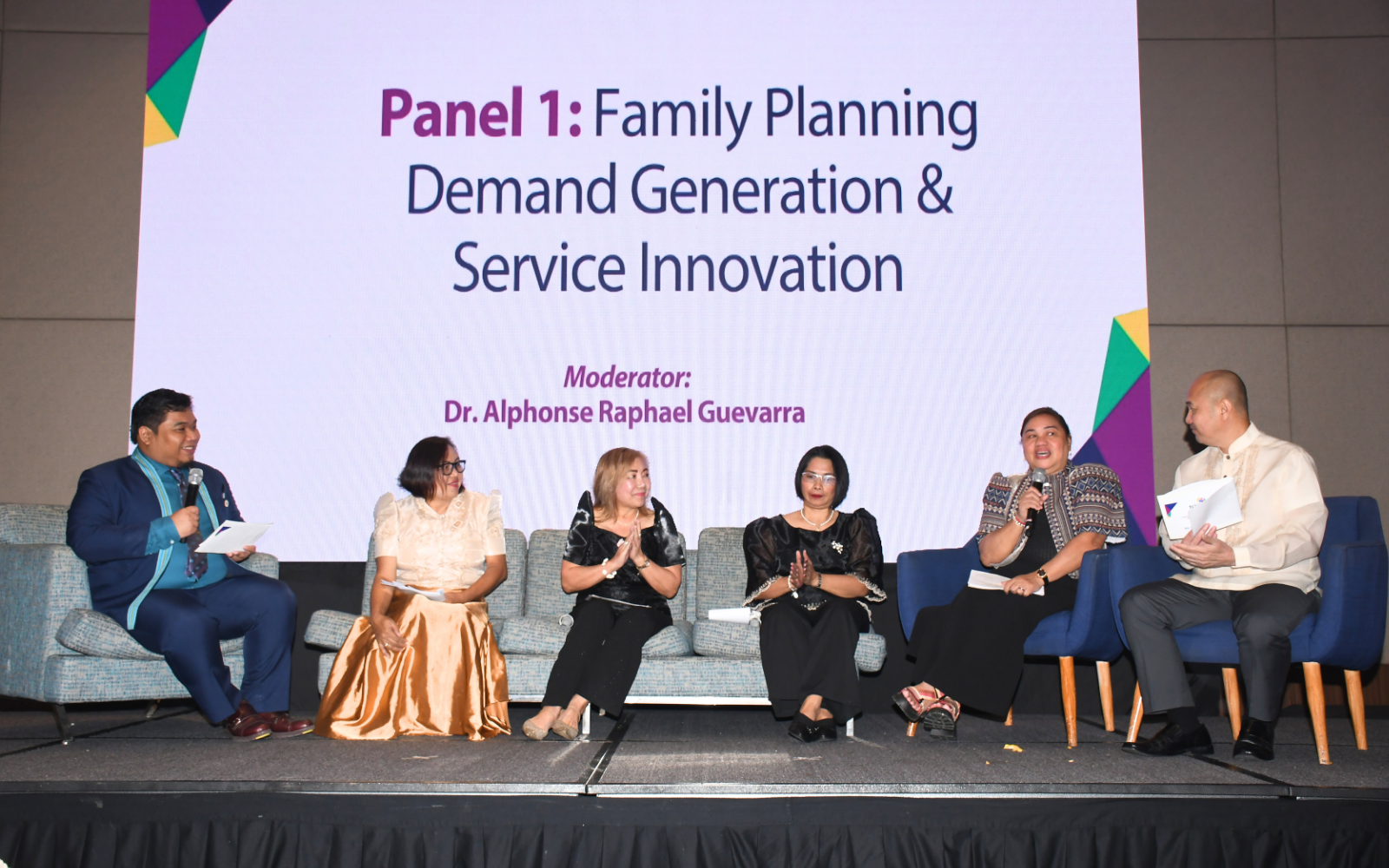
Cities showcased innovative approaches that expanded access and inclusivity in family planning services:
- Tagum City – Mobilized grassroots leaders and youth advocates through Usapang Youth and KATROPA sessions, engaging men and youth as champions of reproductive health.
- General Santos City – Expanded outreach to underserved women through Family Planning Itinerant Teams and long-acting reversible contraceptives (LARCs).
- Lapu-Lapu City – Empowered barangay health workers as frontline FP service providers.
- Iriga City – Promoted culturally sensitive family planning among 21 Indigenous Peoples (IP) tribes.
- Isabela de Basilan – Localized reproductive health materials into 16 languages to reach more communities.
Panel 2: Adolescent Sexual and Reproductive Health (ASRH) Innovations
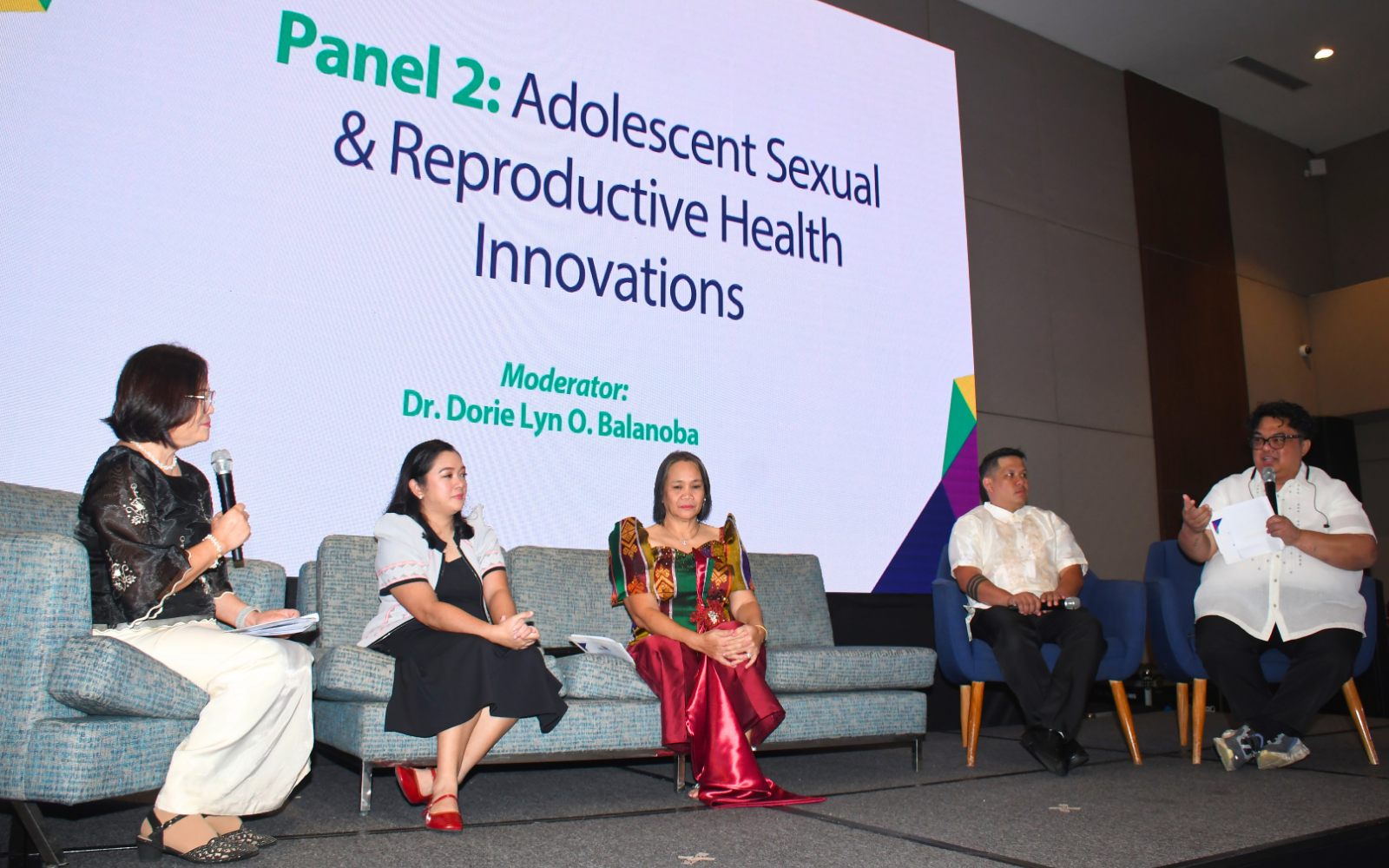
Cities also implemented programs that placed young people at the center of reproductive health advocacy:
- Mandaluyong City – Organized Healthy Young Ones lectures and the Adolescent Congress to create peer-driven learning spaces.
Quezon City – Institutionalized prevention programs through Ordinance No. SP-3128, s. 2021, establishing the Information and Service Delivery Network for Adolescent Health and Development (ISDN4AHD). - Pasig City – Developed a rights-based referral system to link services across agencies.
- Tacurong City – Integrated adolescent-friendly health services across all barangay centers.
Representatives from the graduating cities shared Leadership Narratives, reflecting on their efforts to sustain reproductive health reforms amid political transitions. They emphasized collaboration, data use, and strong community partnerships as key to their success.
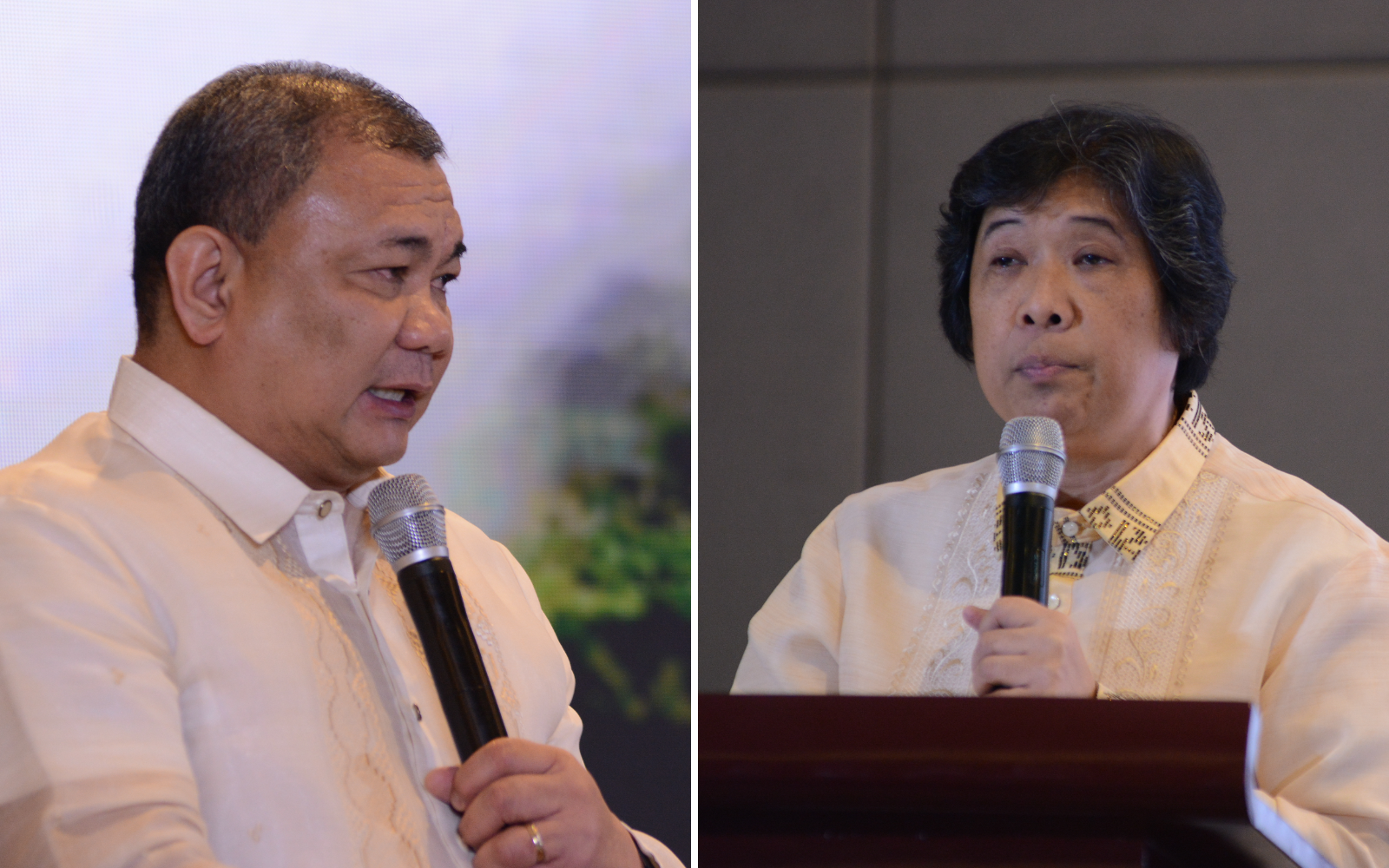
In his closing message, Dr. Manuel M. Dayrit, ZFF Chairman, congratulated the cities for achieving global self-reliance: “You are all part of a global movement called TCI, covering hundreds of cities worldwide. Our local experience has global significance.”
As of September 2025, ZFF and its partners under TCI-Philippines recorded the following results across 24 cities:
- 947 Master Coaches trained nationwide;
- 209,574 additional family planning clients served;
- 21,589 outreach and demand-generation activities conducted;
- 577 health facilities certified as adolescent-friendly; and
- 780 facilities offering post-pregnancy family planning services.
These accomplishments reflect a shared lesson from the colloquium: that locally led, evidence-based, and community-rooted approaches can sustain reproductive health gains and inspire other local governments across the country.
Sustaining Momentum: Cities Continue Transformative Reproductive Health Work through Data-Driven Leadership
The Challenge Initiative (TCI)-Philippines, implemented by the Zuellig Family Foundation (ZFF), will hold its Batch 3 Colloquium on October 14, 2025, bringing together nine cities that have made strides in improving family planning (FP) and adolescent and youth sexual and reproductive health (AYSRH).
The event, themed “Sustaining Momentum: Transformative Reproductive Health Impact through Data-Driven Leadership,” celebrates the achievements of General Santos, Iriga, Isabela de Basilan, Lapu-Lapu, Pasig, Mandaluyong, Quezon City, Tacurong, and Tagum, the final cohort of TCI-Philippines.
Over the past three years, these cities have shown how innovation, local leadership, and data use can translate into tangible gains—raising modern contraceptive prevalence rates (mCPR) and reducing adolescent birth rates (ABR). Their experiences highlight that locally led and evidence-based programs can drive lasting impact, even amid political and social changes.
Through the support of TCI-Philippines and ZFF, local governments designed and implemented tailored initiatives addressing their communities’ specific needs:
- Tagum City engaged men and youth as advocates, increasing awareness and participation in FP.
- General Santos City expanded access to modern contraceptives by deploying FP Itinerant Teams to reach underserved communities.
- Lapu-Lapu City strengthened service continuity by empowering barangay health workers to deliver FP services.
- Iriga City and Isabela de Basilan improved inclusivity by tailoring FP efforts to indigenous peoples through localized communication strategies.
- Mandaluyong City reduced adolescent pregnancies through community group engagement
- Quezon City institutionalized adolescent pregnancy prevention through an ordinance, creating a coordinated network for youth health and development.
- Pasig City improved adolescent-friendly health services through a comprehensive Information and Service Delivery Network (ISDN).
- Tacurong City integrated adolescent needs into regular health services, ensuring continued access to reproductive health care.
These innovations build on the lessons of previous TCI-Philippines batches in Cagayan de Oro, Dipolog, Puerto Princesa, Baguio, San Jose, Iligan, Naga, Santiago, Biñan, Mandaue, Manila, Iloilo, and Las Piñas, whose experiences affirm that sustained political commitment, data use, and community engagement are key to improving reproductive health outcomes.
Click to join us via Zoom
As TCI-Philippines concludes its final cohort, the Colloquium aims to showcase city achievements, share best practices, and inspire other local governments to adopt scalable and sustainable approaches to FP and AYSRH.
Related articles:
Mandaue City’s Path Toward Sustainable Family Planning and Adolescent Health
The Zuellig Family Foundation, through its The Challenge Initiative (TCI)-Philippines team, met with Mandaue City Mayor Thadeo Jovito “Jonkie” Ouano, City Health Officer Dr. Debra Maria Catulong, and the dedicated staff of the City Health Office. The discussion highlighted the city’s steady progress in advancing family planning and adolescent health services over the past two years, while also laying out a shared vision to sustain and build on these gains in the years to come.
Bringing Services Closer to Families
When Mandaue City first joined TCI in 2023, access to family planning was limited. Only five midwives in the entire city had the skills to provide certain contraceptive services, and residents often had to travel far or wait for schedules to receive care. Today, that situation has been transformed. All 27 barangay health centers now have trained midwives, nurses, and doctors who can provide modern contraceptives on a daily basis.
This decentralization of services has had a direct impact on families. The city’s modern contraceptive prevalence rate has risen from 19 percent in 2020 to 30 percent in 2024—meeting the national target. Behind these numbers are women who are better able to space their pregnancies, parents who can provide for their families with greater stability, and adolescents who can make informed choices about their futures.
Related articles:
- Mandaue City Redefines Reproductive Care through Women’s Health Caravan
- Eight Cities Share Success in Family Planning and Adolescent Health
Making Services Adolescent-Friendly
The city also recognized early on that adolescents face distinct barriers when seeking health services. Young people often hesitate to ask for help because of stigma or fear of being judged. To address this, Mandaue invested in adolescent-friendly health services (AFHS), redesigning facilities to ensure privacy and training staff to listen and respond without judgment.
As of today, ten barangays have already achieved certification from the Department of Health as adolescent-friendly, and the rest are moving toward the same goal. With these changes, adolescents in Mandaue are finding spaces where they feel welcome, safe, and respected.

Integrating Family Planning into Everyday Care
A significant innovation in Mandaue has been the integration of family planning into the full range of health activities. Whether through immunization drives, cancer screenings, or women’s health check-ups, family planning has become part of routine care. This approach helps normalize conversations about reproductive health and ensures that no opportunity is missed to provide information and services.
Investing in Sustainability
The city has also demonstrated strong political and financial commitment. From 2.5 million pesos in 2024, the budget for family planning and adolescent health rose to 12 million pesos in 2025—a fivefold increase. This reflects both the prioritization of reproductive health and the recognition of its importance in improving overall well-being.
At the same time, Mandaue is pursuing PhilHealth accreditation for its facilities and providers. This will allow reimbursements to flow back into the health system, creating a financial cycle that sustains services over time. Coupled with the Special Health Fund under Universal Health Care, the city is positioning itself for long-term continuity of family planning and adolescent health programs.
Key Lessons from Mandaue’s Experience
Several lessons stand out from Mandaue City’s journey. Strong local leadership, led by the mayor and supported by the city council, has been central to accelerating reforms. Systems change is possible when local governments commit to decentralization, integration, and youth-friendly service delivery. Listening to adolescents and families has helped ensure that services are relevant and stigma-free. Finally, financial sustainability must be built deliberately, as demonstrated by the city’s budget increases and its pursuit of PhilHealth reimbursements.
Looking Ahead
Despite these successes, challenges remain. The city aims to achieve adolescent-friendly certification across all barangays, expand peer education networks, and continue strengthening data quality and use. Ensuring a consistent supply of commodities and fully utilizing available budgets will also be critical to sustaining progress.
What is most notable is the sense of ownership within Mandaue City. Local leaders, health workers, and communities see these programs not as external projects but as their own responsibility. This perspective is the clearest sign that sustainability is within reach.
Mandaue City’s story is one of determination, innovation, and leadership. From expanding access to family planning, to creating youth-friendly spaces, to embedding sustainability through financing, the city has demonstrated how local governments can drive meaningful health reforms.
By making services more accessible to families and more welcoming to adolescents, Mandaue is showing what it means to build a healthier and more empowered community. Its experience serves as a model for other cities in the Philippines—and beyond—on how to combine political will, systems strengthening, and community-centered design to achieve lasting impact.
Meeting photos from: Mandaue City Public Affairs Office
Author: Dr. Anthony Faraon, ZFF TCI-Philippines Chief of Party
Lapu-Lapu City’s Path to Strengthening Family Planning and Adolescent Health
On September 18, 2025, the Zuellig Family Foundation, through its The Challenge Initiative (TCI)-Philippines team, met with the Lapu-Lapu City government to discuss family planning and adolescent health. Joining the meeting were City Administrator Atty. Almendras and the City Health Office team, led by nurses Ivy Amistad, Jovy Alonzo, and Leizel Lagtapon. The conversation served as a chance to reflect on the city’s progress, identify ongoing challenges, and consider ways to strengthen impact and sustainability.
Recovery and Resilience after COVID-19
Like many local government units, Lapu-Lapu City experienced major disruptions in reproductive health services during the COVID-19 pandemic. Health workers were diverted to pandemic response, service delivery slowed, and demand for family planning dropped. Now, the City is steadily regaining momentum. With health staff back on the ground, there has been recovery in the uptake of short-acting methods such as pills, injectables, and condoms. Encouragingly, long-acting and permanent methods (LAPMs) like implants, intrauterine devices (IUDs), and sterilization are also increasing in demand.
One area where Lapu-Lapu has exceeded expectations is in postpartum family planning (PPFP). Through sustained training and outreach activities, the city has exceeded its TCI commitment of ensuring that targeted providers are trained on PPFP–demonstrating that with political will and operational focus, service delivery can quickly regain strength.
Related article:
Addressing the Data Gap
Reliable data is critical for decision-making, yet the city continues to face difficulties in capturing a complete picture of family planning performance. Public facilities generally provide regular reports, though private birthing centers and hospitals show variable compliance rates. An ordinance requires reporting, but enforcement is limited without established legal penalties. The City Health Office is considering connecting compliance requirements to business permit processes and incorporating maternal death review procedures as accountability measures.
Another challenge lies in the transition to new Department of Health (DOH) performance indicators. Health staff are still adjusting from measuring modern contraceptive prevalence rate (mCPR) to tracking “demand satisfied”, which looks at the percentage of women with demand for family planning and who are actually using modern methods. Lapu-Lapu currently reports a demand satisfied rate of only 46%, far below the 70% national target. Continued coaching and capacity building will be essential to ensure that data is not only accurate but also used strategically for planning and advocacy.
Investing in Young People
Adolescent health remains a priority in Lapu-Lapu. Several health workers have been trained on adolescent-friendly health services (AFHS), and facilities are starting to offer confidential, youth-centered care. While formal DOH accreditation is still in development for most facilities, efforts are underway to address infrastructure needs, including the establishment of appropriate counseling spaces.
Despite these challenges, peer education is emerging as a promising practice. By mobilizing young people themselves to reach their peers, the city is creating more relatable and effective pathways to information and services. Plans are underway to expand peer education networks through collaboration with the Sangguniang Kabataan (SK) Federation and barangay-level initiatives. For sustainability, the city will need to determine the right peer-to-population ratio to ensure meaningful coverage across communities.
Governance, Financing, and Sustainability
Lapu-Lapu has demonstrated strong commitment to financing reproductive health, earmarking four million pesos in 2024 and five million pesos in 2025 for FP and adolescent health.
Budget execution has been gradual, with 22% of funds utilized by mid 2025, indicating opportunities to accelerate implementation timelines to maintain program momentum. This highlights the potential for strengthening alignment between program objectives and financial planning. For example, advancing demand satisfied rates from 46% to 60% would involve specific resource requirements for peer educators, supplies, and community outreach activities, each with defined costs. Developing such costing frameworks could support city leadership, including the mayor and city council, in making strategic resource allocation decisions for optimal program impact.
In May 2025, the City completed a self-reliance assessment using TCI’s Reflection and Action to Improve Self-reliance and Effectiveness (RAISE) Tool. The results showed strong performance in data management (100%) and leadership (85%). However, areas needing improvement include formalizing policies, ensuring specific line-item allocations for FP and adolescent health, and strengthening supportive supervision systems. These gaps highlight where technical assistance and local leadership need to converge to ensure sustainability.
Moving Ahead
The meeting underscored both the progress and the unfinished work in Lapu-Lapu City’s reproductive health journey. On the one hand, the city has demonstrated resilience, ownership, and momentum—recovering service delivery, expanding postpartum FP, and investing in adolescent-friendly health services. On the other hand, challenges remain: persistent gaps in data reporting, budget execution, and demand satisfied rates reveal the need for stronger systems and sharper strategies.
With committed leadership, available resources, and the support of partners like ZFF and TCI, Lapu-Lapu City is well-positioned to transform these challenges into breakthroughs. By enforcing policies, scaling up peer-led youth programs, and aligning financial investments with program outcomes, the city can not only close its current gaps but also emerge as a model for sustainable, locally-owned family planning and adolescent health programs in the Philippines.
Author: Dr. Anthony Faraon, ZFF TCI-Philippines Chief of Party
Iloilo City Takes Bold Steps in Family Planning and Adolescent Health
Iloilo City has been working hard to improve its Family Planning (FP) and Adolescent Sexual and Reproductive Health (ASRH) services since joining The Challenge Initiative (TCI)-Philippines in May 2023. With committed leaders and policies based on data, the city is making huge progress in bringing health programs closer to communities and solving long-standing problems with high-impact, locally adapted solutions.
A recent trip to the field on August 20, 2025 gave a firsthand look at the progress being made and the energy that everyone is putting into it.
Health in Action in the Community
The opening of Iloilo City’s first PuroKalusugan in the Arevalo District was a big step forward for community-based service delivery. This program provides health services right to the purok, which is the smallest unit of a community. This makes healthcare easier to get, especially for people who don’t have access to it.
At the launch, attendees had access to a full range of services, such as PhilHealth membership, consultations on maternity and child health, family planning counseling and provision, adolescent health services, nutrition support, and vaccinations. Putting services together shows that there is a plan to cover several health requirements in one easy-to-reach place.
I met two young doctors, Earl Sevilla and Lysander Quintia, working as health center physicians in Iloilo. They are examples of what it truly means to serve the public. Even though they didn’t have a lot of resources and were dealing with problems like teenage pregnancy, rising cases of sexually transmitted diseases (STIs), and the growing trend of vaping among young people, Sevilla and Quintia were nevertheless very determined and passionate. Their choice to work in community settings instead of more lucrative jobs shows how strongly they care about public health and equity.
Related articles:
- Iloilo’s Youth Health Movement in Action
- Eight Cities Share Success in Family Planning and Adolescent Health
Leadership That Listens and Leads
Strong leadership is setting Iloilo’s health agenda at the policy level. During a visit to City Hall, Vice Mayor Lady Grace Julie Baronda, a vibrant leader with legislative experience, showed great interest in learning more about the health concerns that need policy assistance or institutionalization. Her willingness to a dialogue shows that she believes in a style of government that values evidence, working together, and community voices.
Grace Hofilena, representative from the Office of Mayor Raisa Trenas, said the same thing. She conveyed that the Mayor strongly supports the program and wants to keep working with TCI. This support from institutions is really important for sustainability and ensuring programs and policies have lasting effect.
The City Leadership Team’s data shows the results of these concerted efforts. From 2020 to 2025, the modern contraceptive prevalence rate (mCPR) went up from 39% to 41%, while the percentage of demand satisfied* rose from 79% to 88%. Although the adolescent birth rate (ABR) has stayed the same at 19 per 1,000, it is evident that further action is needed.
The city’s big budget increase for family planning—from 765,000 pesos in 2023 to 8 million pesos in 2025—may be the best indicator of political will. This jump shows that FP is not only a programming priority, but also a financial one, thanks to excellent leadership.
Persistence and Progress
When local leaders, health workers, and communities work together toward a common goal, like they did in Iloilo City, progress in public health is both attainable and realistic. But there are still challenges. Teenage pregnancies, STIs, and dangerous behaviors among teens are still putting a lot of stress on the system. To solve these problems, we need more than just technical fixes. We need to keep coming up with new ideas, work together across sectors, and get the community involved.
The field visit showed not only what the city has done well, but also the qualities that support those achievements: compassion, resilience, and responsibility. Health workers are making services more accessible to people who live nearby. Local leaders are using policy and budgets to drive sustainability. And young professionals are putting service and making a difference ahead of their own interests.
A Model for Local Health Governance
The last two years have shown how powerful local governments can be in Iloilo City. They can achieve real, quick progress in important health areas when they have the necessary tools, data, and assistance. The city’s increasing investments in FP and ASRH demonstrate that robust political commitment, alongside community-driven innovation, can yield tangible outcomes.
The lessons from Iloilo are clear: to improve family planning and adolescent health, we need more than just one-time action. It needs changes to the whole system, shared accountability, and working together. Iloilo City is a great example for other communities in the Philippines that want to invest in the health and future of their families and young people.
—
* Demand satisfied refers to the percentage of women of reproductive age who want to delay or avoid pregnancy and are actually using a modern contraceptive method.
Author: Dr. Anthony Faraon, ZFF TCI-Philippines Chief of Party
No Detours: Building Expressways to Adolescent Health
The road to a healthier future for Filipino youth is not a scenic route—it’s an expressway we need to build now. Last week in Bohol, at the Adolescent Health Learning Exchange (AdHLEx)—organized by the Department of Health (DOH) Adolescent Health Unit and DOH Center for Health Development VII—government leaders, health professionals, civil society, and young people gathered to map that route.
The metaphor of roads—national highways, boulevards, crossroads, and yes, rough roads—showed both how far we had come and how far we had fallen off the track. On the “national highway” are broad policy frameworks like the Universal Health Care (UHC) Act and the Responsible Parenthood and Reproductive Health (RPRH) Law. On the “boulevards” are adolescent sexual and reproductive health (ASRH) services. At the “crossroads” stand local governments and multi-sectoral teams deciding whether to press forward or stall. Far too many young Filipinos also find themselves on “rough roads” marked by early pregnancy, mental health struggles, and lack of access to care.
National data gives us a mixed view. According to the Commission on Population and Development (CPD), adolescent birth rates (ABR) in the Philippines have generally declined in recent years—a sign that sustained interventions are working. However, there has been a rise in births among girls aged 10 to 14 years old, which is a real concern. These pregnancies are often the product of abuse and exploitation, and they can have lifelong consequences for the health, education, and well-being of these children. This is not just a statistic—it’s a warning sign.
The lesson from Bohol is crystal clear: adolescent health cannot be treated as a side street. It must be central to our public health and development agenda. That means three things.
First, integration. ASRH is not separate from mental health, nutrition, or protection from abuse—they are all part of the same path. A national plan that doesn’t reach the barangay health station or school clinic is a highway that ends in a dead zone.
Second, youth participation. In Bohol, young leaders were not tokens on a panel; they were drivers of solutions—designing peer-led programs, confronting stigma, and reaching peers in ways adults can’t. We cannot plan adolescent health “for them” without planning it “with them”.
Third, scaling innovation. From peer education networks to mobile health clinics, the solutions already exist in pockets of the country. The challenge is not invention—it’s political will, financing, and replication at scale.
This is where the work of The Challenge Initiative (TCI)-Philippines offers important lessons. In 24 cities across the country, TCI has worked with local government units (LGUs) to make high-impact practices for ASRH a permanent part of their work. These include strengthening leadership teams, training health workers, making health facilities more welcoming to young people, and embedding adolescent health in local investment plans.
Related article:
For example, in several LGUs where TCI support was sustained, adolescent birth rates among 15–19-year-olds dropped significantly within a few years. Cities have adopted referral systems linking schools, barangay health stations, and hospitals; improved commodity security for contraceptives; and launched social behavior change campaigns that reach both in-school and out-of-school youth. These are not just pilot initiatives that go away when funding ends—they are built into LGU budgets, policies, and processes.
TCI’s approach proves that with local ownership, data-driven planning, and community engagement, adolescent health programs can produce measurable results. But the rise in pregnancies among the youngest girls shows there are still gaps in protection, prevention, and early intervention. LGUs need to strengthen links with child protection mechanisms, expand mental health services, and equip frontline workers to detect and respond to abuse swiftly.
The Special Health Fund under the UHC Law offers an untapped opportunity. LGUs can earmark these pooled resources for adolescent health—financing outreach programs, peer education, and youth-friendly clinics. Schools can become gateways to care, not just sources of information, by partnering with health providers for on-site services. Communities can become safe spaces where adolescents access help without fear or shame.

We are in a race against time. Every delay means another young life derailed by preventable pregnancy, untreated mental health issues, or violence. The choice is ours: keep patching potholes, or build the expressways our adolescents deserve.
At AdHLEx, we chose the latter. Leaders from national agencies, local governments, and the youth sector committed to accelerate progress, address the alarming rise in pregnancies among the youngest girls, and ensure every adolescent in the Philippines can grow up healthy, educated, and safe.
The rest of the country must follow—not someday, but now.



